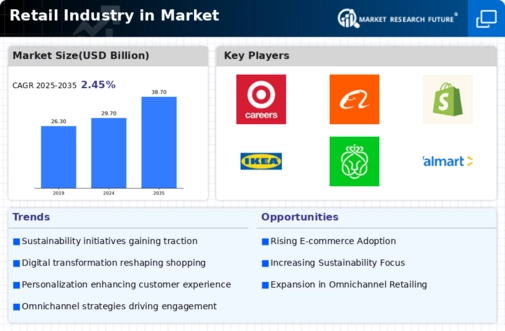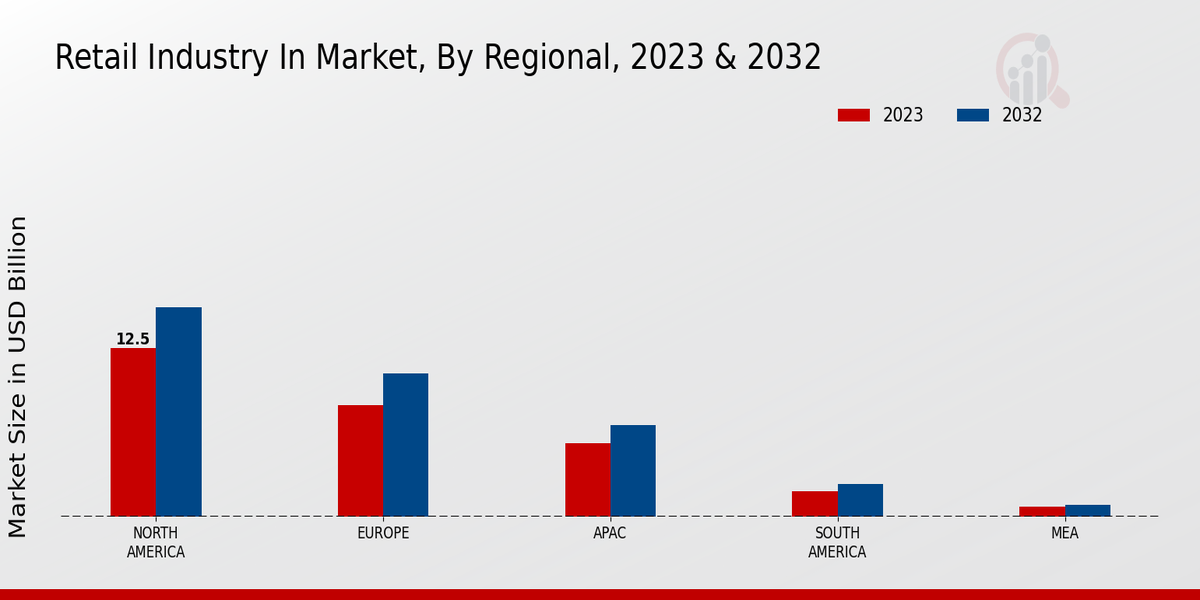E-commerce Expansion
The Global Retail Industry in Market is experiencing a notable shift towards e-commerce, driven by increasing internet penetration and consumer preference for online shopping. In 2024, the e-commerce segment is projected to contribute significantly to the overall market, which is valued at 29.7 USD Billion. Retailers are investing in digital platforms to enhance customer experience and streamline operations. For instance, major retailers are adopting omnichannel strategies to integrate online and offline shopping experiences. This trend is likely to continue, as consumers increasingly seek convenience and accessibility, suggesting a robust growth trajectory for the e-commerce sector within the Global Retail Industry in Market.
Market Growth Projections
The Global Retail Industry in Market is projected to experience steady growth, with estimates indicating a rise from 29.7 USD Billion in 2024 to 38.7 USD Billion by 2035. This growth reflects a compound annual growth rate (CAGR) of 2.46% for the period from 2025 to 2035. Various factors, including technological advancements, changing consumer preferences, and sustainability initiatives, are expected to contribute to this upward trend. Retailers that effectively adapt to these dynamics are likely to capitalize on emerging opportunities, thereby enhancing their market position in the evolving landscape.
Sustainability Initiatives
Sustainability is becoming a pivotal driver in the Global Retail Industry in Market, as consumers increasingly prioritize eco-friendly products and practices. Retailers are responding by adopting sustainable sourcing, reducing waste, and implementing energy-efficient operations. This shift not only meets consumer demand but also aligns with regulatory pressures for environmental responsibility. For example, brands are launching initiatives to reduce carbon footprints and promote circular economy practices. As sustainability becomes a core value proposition, it is expected to influence purchasing decisions, thereby enhancing brand loyalty and potentially driving market growth in the coming years.
Technological Advancements
Technological innovations are reshaping the Global Retail Industry in Market, enhancing operational efficiency and customer engagement. Retailers are leveraging artificial intelligence, machine learning, and data analytics to personalize shopping experiences and optimize inventory management. For instance, predictive analytics allows retailers to anticipate consumer demand, thereby reducing excess inventory and improving profitability. As technology continues to evolve, it is likely to facilitate seamless transactions and enhance customer interactions, contributing to the projected market growth from 29.7 USD Billion in 2024 to 38.7 USD Billion by 2035, with a CAGR of 2.46% for the period from 2025 to 2035.
Changing Consumer Preferences
The Global Retail Industry in Market is significantly influenced by shifting consumer preferences, particularly among younger demographics. There is a growing inclination towards personalized shopping experiences, ethical consumption, and unique product offerings. Retailers are adapting by curating assortments that resonate with these values, often utilizing social media platforms for marketing and engagement. This trend indicates a potential for increased customer loyalty and repeat purchases, as brands that align with consumer values are likely to thrive. Consequently, understanding and responding to these evolving preferences is crucial for retailers aiming to capture market share in the competitive landscape.
Global Supply Chain Optimization
Supply chain optimization is a critical driver for the Global Retail Industry in Market, particularly as retailers seek to enhance efficiency and reduce costs. The integration of advanced logistics technologies and real-time data analytics is enabling retailers to streamline operations and improve inventory turnover. For example, just-in-time inventory systems are being adopted to minimize holding costs and respond swiftly to market demands. As global trade dynamics evolve, effective supply chain management will likely play a pivotal role in maintaining competitiveness and profitability within the industry. This focus on optimization is expected to support the overall growth trajectory of the market.
















